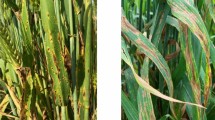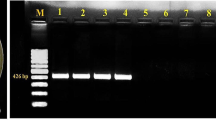Abstract
To study the cultural, morphological and molecular diversity of Ascochyta rabiei infecting chickpea, 44 isolates were sampled from three different agro climatic regions of India over three years (2016–17, 2017–18 and 2018–19). Colony color of the A. rabiei isolates had varied shades of gray and white and produces flat and irregular colonies on potato dextrose agar. The growth rates of isolates varied from 1.02 to 2.46 mm/day. The higher conidial density of 4.05 × 10–6 was recorded in isolate AR-35. Molecular diversity data revealed that out of 58 RAPD markers, 43 markers produced polymorphic band among the 44 isolates with the PIC value ranged from 0.01 to 0.28. Maximum PIC value were revealed by the markers viz., OPA18 (0.2160), OPAU 12 (0.2496), OPB 06 (0.2275) and OPB 09 (0.2805). In cluster analysis isolates were categorized into six different clusters based on 72% similarity. The cluster VI consists of AR-11 and AR-5. The isolate AR-5 found to be diverge from the rest of the isolates and clusters. The cultural, morphological and genetic diversity studies established the existence of diversity and higher gene flow among the isolates of A. rabiei. Mutation and recombination are the main factors for their diversity. The results of the study help in developing resistant cultivars for newly evolving strains of A. rabiei.




Similar content being viewed by others
Availability of data and material (data transparency)
Original research
References
Ahmad S, Khan MA, Sahi ST, Ahmad R (2014) Identification of resistant sources in chickpea against chickpea blight disease. Arch Phytopathol Plant Prot 47:1885–1892
Baite MS, Dubey SC, Singh B (2016) Morphological variability in the Indian isolates of Ascochyta rabiei causing blight in chickpea and evaluation of chickpea cultivars. Indian J Pl Protect 44(1):74–82
Bar I, Sambasivam PT, Davidson J, Farfan-Caceres LM, Lee RC, Hobson K, Moore K, Ford R (2021) Current population structure and pathogenicity patterns of Ascochyta rabiei in Australia. Microb Genom 7(7):000627. https://doi.org/10.1099/mgen.0.000627
Barve MP, Arie T, Salimath SS, Muehlbauer FJ, Peever TL (2003) Cloning and characterization of the mating type (MAT) locus from Ascochyta rabiei (teleomorph: Didymella rabiei) and a MAT phylogeny of legumes-associated Ascochyta spp. Fungal Genet Biol 39:151–167
Basandrai AK, Pande S, Kishore GK, Crouch JH, Basandrai D (2005) Cultural, morphological and pathological variation in Indian isolates of Ascochyta rabiei, the chickpea blight pathogen. Plant Pathol J 21:207–213
Bayraktar H, Dolar FS, Tor M (2007) Determination of genetic diversity within Ascochyta rabiei (Pass.) Labr., the pathogen of ascochyta blight of chickpea in Turkey. J Plant Pathol 89:341–347
Benzohra IE, Bendahmane BS, Labdi M, Benkada MY (2012) Determination of pathotypes and physiological races in Ascochyta rabiei, the agent of Ascochyta blight in chickpea (Cicer arietinum L.) in Algeria. Afr J Agric Res 7:1214–1219
Benzohra IE, Bendahmane BS, Labdi M, Benkada MY (2013) Sources of resistance in chickpea germplasm to three pathotypes of Ascochyta rabiei (Pass.) Labr. in Algeria. World Appl Sci J 21(6):873–880
Chongo G, Buchwaldt L, Anderson K, Gossen BD (2000) Saskatchewan chickpea disease survey, 1999. Can Plant Dis Surv 80:86–87
Dolar FS, Tenuta A, Higgins VJ (1994) Detached leaf assay for screening chickpea for resistance to Ascochyta blight. Can J Plant Pathol 16(3):215–220
Farahani S, Talebi R, Maleki M, Mehrabi R, Kanouni H (2019) Pathogenic diversity of Ascochyta rabiei isolates and identification of resistance sources in core collection of chickpea germplasm. Plant Pathol J 35:321–329
Farahani S, Talebi R, Maleki M, Mehrabi R, Kanouni K (2021) Mating type distribution, genetic diversity and population structure of Ascochyta rabiei, the cause of Ascochyta blight of chickpea in western Iran. Phytopathol Mediterr 60(1):3–11. https://doi.org/10.36253/phyto-11616
Food and Agricultural Organization of the United Nations, Rome, Italy (2018) www.fao.org
Gomez AK, Gomez A (1984) Statistical procedures for agricultural research. Wiley, New York
Harveson RM, Markell SG, Goswami R, Urrea CA, Burrows ME, Dugan F, Chen W, Skoglund G (2011) Ascochyta blight of chickpeas. Plant Health Progress 12(1):30
Jan H, Wiese MV (1991) Virulence forms of Ascochyta rabiei affecting chickpea in the Palouse. Plant Dis 75:904–906
Jukanti AK, Gaur PM, Gowda CLL, Chibbar RN (2012) Nutritional quality and health benefits of chickpea (Cicer arietinum L.): a review. Brit J Nutr 108(S1):S11–S26
Kaiser WJ, Muehlbauer FJ (1989) An outbreak of ascochyta blight of chickpea in the Pacific Northwest, USA. Int Chickpea Newsl 18:16–17
Kanouni H, Taleei A, Okhovat M (2011) Ascochyta blight (Ascochyta rabiei (Pass.) Lab.) of chickpea (Cicer arietinum L.): breeding strategies for resistance. Int J Plant Breed Genet 5:1–22
Manjunatha L, Saabale PR, Srivastava AK, Dixit GP, Yadav LB, Krishna K (2018) Present status on variability and management of Ascochyta rabiei infecting chickpea. Indian Phytopathol 71:9–24. https://doi.org/10.1007/s42360-018-0002-6
Manjunatha, L, Upasana R, Shailendra S, Mamta S, Krishna K, Singh NP (2019) Pathotypes and Racial diversity of Ascochyta rabiei isolates in India. In: “XIX International Plant Protection Congress IPPC 2019” on ‘Crop protection to outsmart climate change for food security and environmental conservation’ held from 10-14th November 2019 at Hyderabad, pp 275
Manjunatha L, Saabale PR, Srinivasa N, Bandi S, Singh S, Kumar K (2021) Molecular characterization and development of sequence characterized amplified region (SCAR) marker for detection of Ascochyta rabiei (Pass.) Labr., infecting chickpea. Indian Phytopathol 74(3):605–613. https://doi.org/10.1007/s42360-021-00345-z
Navas-Cortes JA, Perez-Artes E, Jimenez-Diaz RM, Llobell A, Bainbridge BW, Heale JB (1998) Mating type, pathotype and RAPDs analysis in Didymella rabiei, the agent of ascochyta blight of chickpea. Phytoparasitica 26(3):199–212
Nene YL (1982) A review of Ascochyta blight of chickpea. Trop Pest Manage 28:61–70
Nene YL, Reddy MV (1987) Chickpea diseases and their control. In: Saxena MC, Singh KB (eds) The chickpea. CAB International, Wallingford, pp 233–270
Ozer G, Bayraktar H, Sara Dolar F (2012) Genetic diversity and mating-type distribution within populations of Ascochyta rabiei in Turkey. IJAS 82(1):3–7
Pande S, Siddique KHM, Kishore GK, Bayaa B, Gaur PM, Gowda CLL, Bretag TW, Crouch JH (2005) Ascochyta blight of chickpea (Cicer arietinum L.): a review of biology, pathogenicity and disease management. Aust J Agric Res 56:317–332
Pande S, Sharma M, Gaur PM, Gowda CLL (2010) Host plant resistance to Ascochyta blight of chickpea. Information Bulletin No. 82. International Crops Research Institute for the Semi-Arid Tropics, 40 pp
Porta-Puglia A (1992) Variability of Ascochyta rabiei. In: Singh KB, Saxena MC (eds) Disease resistance in chickpea. ICARDA, Aleppo, pp 135–143
Rohlf FJ (1993) NTSYS-pc: numerical taxonomy and multivariate analysis system version 1.80. Exter software. Setauket, New York
Santra DK, Singh G, Kaiser WJ, Gupta VS, Ranjekar PK, Muehlbauer FJ (2001) Molecular analysis of Ascochyta rabiei (Pass.) Labr., the pathogen of Ascochyta blight in chickpea. Theor Appl Genet 102:676–682
Singh G (1990) Identification and designation of physiological races of Ascochyta rabiei in India. Indian Phytopathol 43:48–52
Singh KB, Reddy MV (1996) Improving chickpea yield by incorporating resistance to ascochyta blight. Theor Appl Genet 92:509–515
Singh KB, Hawtin GC, Nene YL, Reddy MV (1981) Resistance in chickpeas to Ascochyta rabiei. Plant Dis 65:586–587
Taylor DL, Hollingsworth TN, McFarland JW, Lennon NJ, Nusbaum C, Ruess Roger W (2014) A first comprehensive census of fungi in soil reveals both hyperdiversity and fine-scale niche partitioning. Ecol Monogr 84(1):3–20. https://doi.org/10.1890/12-1693.1
Trapero-Casas A, Jim6nez-Diaz RM (1986) Influence of sowing date on Fusarium wilt and Ascochyta blight of chickpea in southern Spain. In: O'Keeffe LE, Muehlbauer EJ (eds) Poster Abstracts, Int. Food Legume Conf. University of Idaho, Moscow, p 11
Tuite J (1969) Plant pathological methods. Fungi and bacteria. Burgess Publ. Co., Minneapolis
Acknowledgements
Authors are grateful to the DST-Science and Engineering Research Board (DST-SERB), New Delhi, Government of India (ECR/2016/000855) for financial assistance to carry out this research. Dr. N. P. Singh, The Director, ICAR-IIPR, Kanpur for constant encouragement and support to conduct this research.
Author information
Authors and Affiliations
Contributions
LM, SS: planning and drafted experiments, collection of fungal isolates, experiments carried out, manuscript preparation, SN and MHS: analysis of morphological and molecular data, UR and YK: helped in isolates collection.
Corresponding author
Ethics declarations
Conflict of interest
The authors declare that they have no contending interests and this research did not involve human beings and/or animals.
Additional information
Publisher's Note
Springer Nature remains neutral with regard to jurisdictional claims in published maps and institutional affiliations.
Rights and permissions
About this article
Cite this article
Manjunatha, L., Rani, U., Singh, S. et al. Morphological and molecular diversity of Ascochyta rabiei (Pass.) Labr. pathogenic to Cicer arietinum L.. Vegetos 35, 415–426 (2022). https://doi.org/10.1007/s42535-021-00322-x
Received:
Revised:
Accepted:
Published:
Issue Date:
DOI: https://doi.org/10.1007/s42535-021-00322-x




